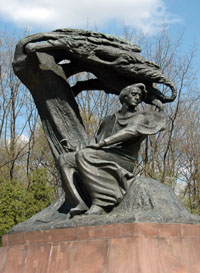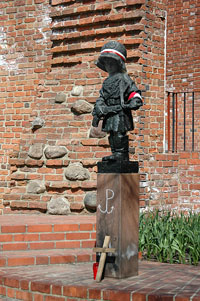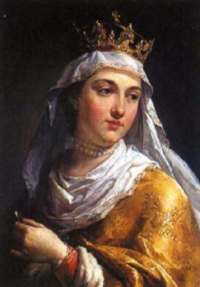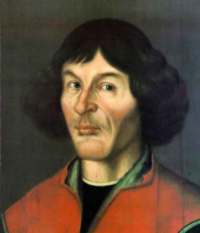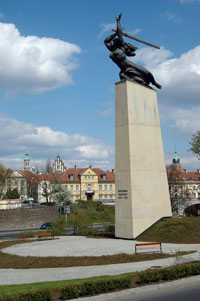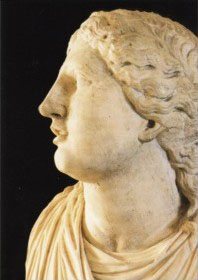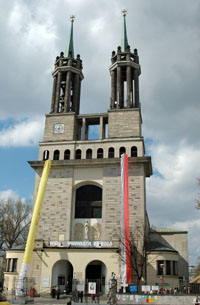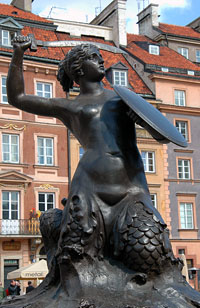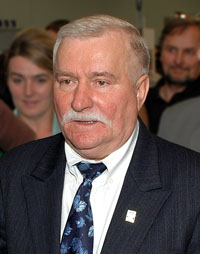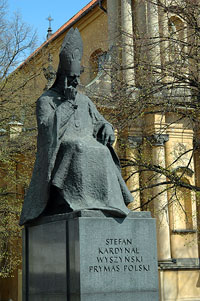WHAT DO THE NAMES OF THE POLISH CLEMATIS CULTIVARS MEAN?
Clematis enthusiasts may be interested in the origin of the names of Polish cultivars, many of these related to the important events in the Polish history and to the famous Poles.
Szczepan Marczyńsk
- ‘Ania’ – a diminutive form of the Polish female name Anna.
- ‘Anna Karolina’ – a Polish female names.
- ‘Bałtyk’ – named after the Baltic Sea because the colour of its flowers is reminiscent of the deep-sea waters.
- ‘Barbara’ – named after the breeder’s wife Barbara Marczyńska.
- ‘Bieszczady’ – mountains in southern Poland, part of the Carpathians.
- ‘Błękitny Anioł’ – in English it means blue angel.
- ‘Danuta’ – a Polish female name.
- ‘Dominika’ – a Polish female name.
- ‘Dorota’ – a Polish female name.
- ‘Dzieci Warszawy’ – Warsaw Children. Named in commemoration of the young participants of the Warsaw Uprising (August 1st – October 3rd 1944) and of the conspiracy movement in Warsaw during the World War II. These adolescents acted as liaisons, as well as took part in sabotage actions and direct fights for the freedom of Warsaw and Poland.
- ‘Emilia Plater’ – commemorates Emilia Plater, the brave officer, who, at the age of 25, was killed during the Polish November Uprising (1830-1831) against Russian occupation. She is recognized as the symbol of Polish women fighting for their country’s independence. Many artists: poets, writers and painters have used her as a motif in their works.
- ‘Fryderyk Chopin’ – named after the Polish composer and pianist, who was born and spent his childhood in Żelazowa Wola, 50 km west of Warsaw.
- ‘Gabriel Narutowicz’ – named after assassinated first president of the Second Polish Republic.
- ‘Generał Sikorski’ – named in honour of Władysław Eugeniusz Sikorski (1881-1943), a Polish general and politician who rendered great service to our country. After the German conquest of Poland in September 1939, he became Prime Minister of the Polish government in exile that was based first in France, and then in England. He was also the commander-in-chief of the Polish air forces that fought alongside the Allies, and of the underground Home Army in occupied Poland. He died on July 4, 1943, in the airplane crash near Gibraltar, in hitherto not established circumstances.
- ‘Gizela’ – a Polish female name.
- ‘Grażyna’ – a Polish female name.
- ‘Halina Noll’ – raised by Władysław Noll and named to honour his daughter.
- ‘Hania’ – named after the breeder’s mother Hanna Marczyńska. Hania is the diminutive form of the name Hanna.
- ‘Izydor’ – a Polish male name.
- ‘Jan Paweł II’ – named in honour of the Pope John Paul II.
- ‘Jerzy Popiełuszko’ – named after Fr Jerzy Popiełuszko (1947-1984), a Catholic priest and a chaplain of Independent Trade Union “Solidarność”. He participated in establishing Workmen Fellowship and from August 1980 was associated with workers and trade unionists. After martial law was declared in Poland on 13 December 1981 he launched various charity activities. He also celebrated masses for the Homeland on regular basis, delivering religious and patriotic sermons. In his sermons everything was called by its proper name, good was good, and evil was evil, truth was truth and lie was lie. He called for respect for human rights and human dignity. He was also actively involved in helping the victims of political persecutions and their families. The quotation “Overcome evil with good” was his motto. In October 1984 he was kidnapped by the officers from the communist Security Service and brutally murdered.
- ‘Joanna’ – a Polish female name.
- ‘Jolanta’ – a Polish female name.
- ‘Julka’ – named after the breeder’s youngest daughter Julianna Marczyńska. Julka is the diminutive form of Julianna.
- ‘Kacper’ – named after Casper, one of the three Wise Men who visited the baby Jesus Christ in Bethlehem.
- ‘Kamila’ – a Polish female name.
- ‘Kardynał Wyszyński’ – named after the Cardinal Stefan Wyszynski (1901-1981). He was a great and just man whose life was an example to others. As the head of the Catholic Church in Poland for over 30 years, he sought to keep the Catholic Church independent from the communist authorities risking his own safety. In 1953 he was arrested and imprisoned for 3 years. He was undeterred in his defence of human dignity against the violation of the intellect and the heart. He called upon all to observe the basic principles of justice and freedom. He initiated the reconciliation between the Poles and the Germans after the atrocities of The World War II. Through his actions and attitude he contributed to the election of Cardinal Wojtyła as the Pope, and to the political changes in the 80’s in Poland. After his death, he was announced the Primate of the Millenary.
- ‘Królowa Jadwiga’ – named after Jadwiga (Hedwig) of Poland, queen (she was monarch – king, not only wife of king) of Poland 1384 – 1399. She is venerated by Roman Catholic Church as Saint Hedwig.
- ‘Kryspina’ – a Polish female name.
- ‘Laura’ – a Polish female name.
- ‘Lech Wałęsa’ – named after Lech Wałęsa, the first chairman of the Independent Trade Union “Solidarność”, from 1980 to 1990. In 1983 he was awarded a Nobel Peace Prize. He was also President of Poland in 1990-1995.
- ‘Maksymilian Kolbe’ – a Polish Conventual Franciscan friar, who volunteered to die in place of a stranger in the Nazi German death camp of Auschwitz, located in German-occupied Poland during World War II. Before his death he was very active in promoting the veneration of the Immaculate Virgin Mary, founding and supervising the monastery of Niepokalanów near Warsaw, operating a radio station, and founding or running several other organizations and publications. Canonized by Pope John Paul II and declared a martyr of charity.
- ‘Matka Siedliska’ – named after Mother Maria Franciszka Siedliska, (1842-1902). She was a diligent and unassuming person. She sacrificed her whole life to God and to people in need. To this end she established the convent of “Holy Family from Nazareth”. She was active in Krakow, Lvov, Rome, Paris, London, New York and Chicago, especially in the circle of Polish emigrants. Mother Siedliska was pronounced Blessed on April 23, 1989.
- ‘Matka Urszula Ledóchowska’ – named after Mother Urszula Ledóchowska (1865-1939). She was a very modest person who made a great contribution to the organisation of education and the upbringing of children and the youth, as well as bringing help to the needy. She was an ardent Polish patriot dedicated to the cause of independence of Poland (after the World War I). She continued her work in tutoring and education in Poland and also in Russia (Petersburg), in Finland, Denmark, France and Italy. She established many children’s homes, preschools, clubs, boarding schools, clinics, training courses, secondary and agricultural schools in the countryside and in the most destitute regions of Poland. She founded the order of the Grey Ursulines, whose main goals are education, raising children and the youth, as well as serving the needy. She was canonised on May 18, 2003.
- ‘Marcelina’ – a Polish female name.
- ‘Mikołaj Kopernik’ – named after Polish astronomer Nicolaus Copernicus.
- ‘Monika’ – a Polish female name.
- ‘Moniuszko’ – named after Stanisław Moniuszko (1819 – 1872) a Polish composer and conductor. He is reffered as the father of Polish national opera. His main operas are Straszny Dwór (The Haunted Manor) and Halka. His output include also many songs.
- ‘Monte Cassino’ – commemorates the battle for the strongly fortified hill of that name to south of Rome, Italy. It was a key point of Gustav line fortification. Three attempts of the allies’ forces failed. Eventually the Polish 2nd Corps succeeded in capturing it after one week of very hard struggle in May 1944, and thus opened the way to Rome to the allies’ forces. There is a Polish military cemetery on Monte Cassino.
- ‘Mazowsze’ – eng. “Masovia” – region in eastern Poland. Warsaw is its capital.
- ‘Mazury’ – eng. “Masuria” – region in northeastern Poland.
- ‘Niobe’ – named for a woman in Greek mythology whom Zeus turned into a rock, and whose children were killed by deities.
- ‘Oberek’ – named for the Polish dance.
- ‘Piotr Skarga’ – named after Piotr Skarga (1536 – 1612) Polish Jesuite, famous preacher and polemicist. He was leading person in counterreformation in the Polish-Lithuanian Commonwealth.
- ‘Polonez’ – named for the Polish dance (Polonaise in English).
- ‘Regina’ – a Polish female name.
- ‘Serafina’ – a Polish female name.
- ‘Słowianka’ – a female of Slavic people.
- ‘Solidarność’ – named after the Independent Trade Union “Solidarność” (in English – Solidarity). Formed in August 1980, it was instrumental in bringing down the communist regime in Poland and consequently in Central and Eastern Europe.
- ‘Solina’ – named after the lake and the village in Bieszczady Mountains in the south-eastern part of Poland.
- ‘Syrena’ – named after The Mermaid (the emblem of the city of Warsaw).
- ‘Vistula’ – named after main river in Poland – Wisła in Polish.
- ‘Warszawska Nike’ – “Nike” is a Greek winged goddess of victory. In Warsaw, “Warszawska Nike” is a monument to the heroes of Warsaw 1939-1945, the soldiers and civilian population who fought during the Second World War for the freedom of their home city. It is particularly dedicated to the participants of the Warsaw Uprising (1 August – 3 October 1944). The fight broke out when the Soviet army had just reached the outskirts of Warsaw and its tanks approached the opposite bank of the Vistula. Over 40,000 soldiers of the Polish underground army stood up to fight on the 1st August 1944. Though very poorly equipped, they managed to release about 50% of the capital territory but since no help came either from the Soviet army (they even stop attacking Germans in this region) or from the western Allies, after over 2 months of hard struggle the uprising ended in the defeat. Nearly 20,000 insurgents and 200 – 300,000 of civil population died, killed off by Germans, most of them shot or burned alive. After that Warsaw was emptied and all survived citizens were sent to concentration camps.
- ‘Westerplatte’– named to commemorate the heroes of the 1st armoured brigade of the Westerplatte peninsula at the Gdansk Bay. During the period between the First and the Second World War there was a Polish military unit at the border of Gdansk City. On the 1st September 1939 (4 a.m.) an armoured German battleship “Schleswig-Holstein” bombarded Westerplatte and this event marked the beginning of the Second World War. Polish Westerplatte unit, numbering 182 soldiers, defended it against overwhelming Nazi forces for 7 days. Since then Westerplatte has become to symbolize soldiers’ heroism.
See description and pictures of all Polish Clematis cultivars in the encyclopaedia.
- Fryderyk Chopin in Łazienki Park, Warsaw, Poland
- “Little Upriser” commemorating children that fought against Germans in Warsaw Uprising in 1944, Warsaw, Poland
- Królowa Jadwiga
- Nicolaus Copernicus
- “Warszawska Nike”, Warsaw, Poland
- Head of Niobe, Rome, 1st/2nd century AD (copy from 18th century AD) in Nieborów, Poland. Photo: courtesy of Nieborów Museum
- St. Stanislaw Kostka Church, where Fr Jerzy Popiełuszko is buried, Warsaw, Poland
- “Syrena” in the Old Town Square, Warsaw, Poland
- Lech Wałęsa
- Stefan Wyszyński by the Church of Wizytki Sisters, Warsaw, Poland

